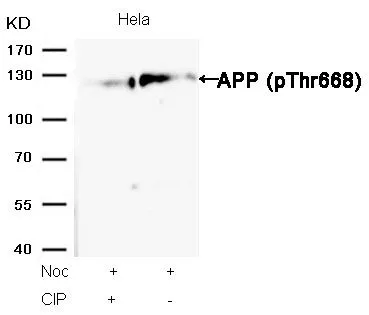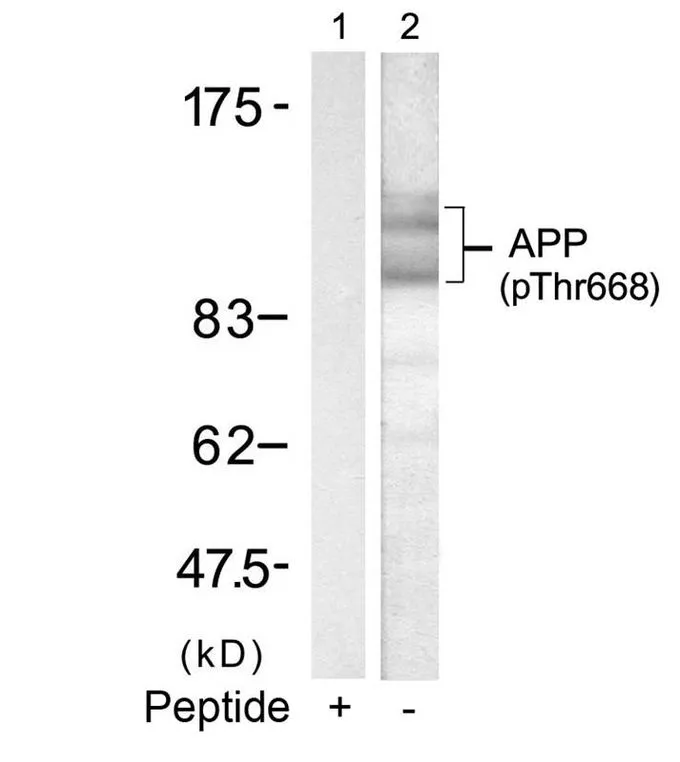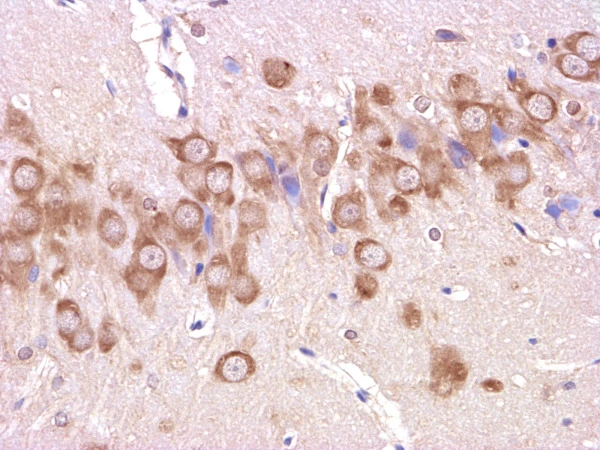
WB analysis of extracts from HeLa cells treated with Noc or calf intestinal phosphatase (CIP) using GTX50235 APP (phospho Thr668) antibody.
APP (phospho Thr668) antibody
GTX50235
ApplicationsWestern Blot
Product group Antibodies
ReactivityHuman, Mouse
TargetAPP
Overview
- SupplierGeneTex
- Product NameAPP (phospho Thr668) antibody
- Delivery Days Customer9
- Application Supplier NoteWB: 1:500-1:1000. *Optimal dilutions/concentrations should be determined by the researcher.Not tested in other applications.
- ApplicationsWestern Blot
- CertificationResearch Use Only
- ClonalityPolyclonal
- Concentration1 mg/ml
- ConjugateUnconjugated
- Gene ID351
- Target nameAPP
- Target descriptionamyloid beta precursor protein
- Target synonymsAAA, ABETA, ABPP, AD1, APPI, CTFgamma, CVAP, PN-II, PN2, alpha-sAPP, preA4, amyloid-beta precursor protein, alzheimer disease amyloid A4 protein homolog, alzheimer disease amyloid protein, amyloid beta (A4) precursor protein, amyloid beta A4 protein, amyloid precursor protein, beta-amyloid peptide, beta-amyloid peptide(1-40), beta-amyloid peptide(1-42), beta-amyloid precursor protein, cerebral vascular amyloid peptide, peptidase nexin-II, protease nexin-II, testicular tissue protein Li 2
- HostRabbit
- IsotypeIgG
- Protein IDP05067
- Protein NameAmyloid-beta precursor protein
- Scientific DescriptionThis gene encodes a cell surface receptor and transmembrane precursor protein that is cleaved by secretases to form a number of peptides. Some of these peptides are secreted and can bind to the acetyltransferase complex APBB1/TIP60 to promote transcriptional activation, while others form the protein basis of the amyloid plaques found in the brains of patients with Alzheimer disease. In addition, two of the peptides are antimicrobial peptides, having been shown to have bacteriocidal and antifungal activities. Mutations in this gene have been implicated in autosomal dominant Alzheimer disease and cerebroarterial amyloidosis (cerebral amyloid angiopathy). Multiple transcript variants encoding several different isoforms have been found for this gene. [provided by RefSeq, Aug 2014]
- ReactivityHuman, Mouse
- Storage Instruction-20°C or -80°C,2°C to 8°C
- UNSPSC12352203
References
- Bukhari H, Kolbe K, Leonhardt G, et al. Membrane tethering of APP c-terminal fragments is a prerequisite for T668 phosphorylation preventing nuclear sphere generation. Cell Signal. 2016,28(11):1725-34. doi: 10.1016/j.cellsig.2016.08.007Read this paper





![ICC/IF analysis of COS7 cells transiently transfected with APP plasmid using GTX84873 APP antibody [4C3].](https://www.genetex.com/upload/website/prouct_img/normal/GTX84873/GTX84873_1270_ICCIF_w_23061420_163.webp)
![ICC/IF analysis of HeLa cells using GTX84877 APP antibody [2B10].](https://www.genetex.com/upload/website/prouct_img/normal/GTX84877/GTX84877_1271_ICCIF_w_23061420_347.webp)
